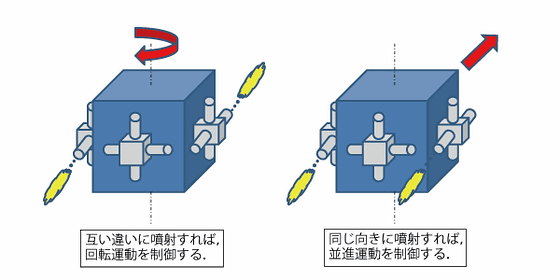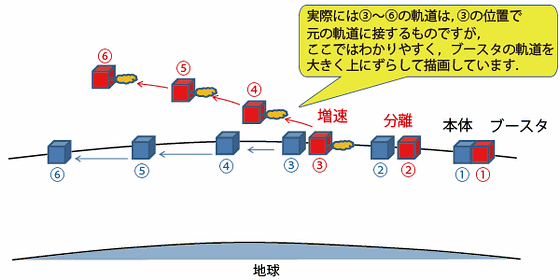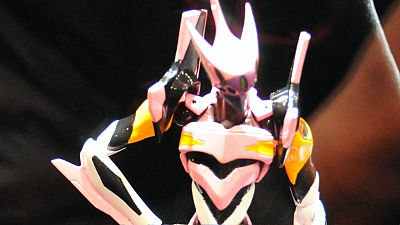This is an amazing page where the Space Systems Laboratory at Tokyo Metropolitan University explains how the 'robbing operation' scene in space at the beginning of Eva Q, 6 minutes and 38 seconds, was serious from a space engineering standpoint.

Tokyo Metropolitan University System Design talked about the outrageous outer space heist operation scene at the beginning of ``
Tokyo Metropolitan University, Faculty of System Design, Aerospace Systems Engineering Course/Space Systems Laboratory Evangelion: New Theatrical Version: Q_First 6 minutes 38 seconds_Explanation of space research
http://www.sd.tmu.ac.jp/ssl/discussion_q.html

[HD] Evangelion New Theatrical Version Q Opening 6 minutes 38 seconds - YouTube
First of all, it is a 'terminology explanation', so you can understand the meaning of phrases that used to be '?' such as various instructions and commands that were played in the background of that scene that was unique to Eva.
For example, it looks like the following.
・Tracking team
When a rocket launches, the rocket is tracked to ensure that it is flying the planned route and is operating normally. Tracking involves ``optical tracking (optical control)'' using the telephoto lens of a telescope or camera, ``telemetry tracking'' using a transponder (trapon) that emits radio waves from the ground, and the rocket receives and returns them, and radar. Examples include 'radar tracking' to obtain position and speed.
Another technology, which is currently still in the research and development stage, is to use image processing technology to extract the object being photographed while photographing it with a camera, and have the camera track the object so that it is located in the center of the screen. There are also attempts to say that.
Normally, these tracking teams work on the ground. Also, tracking can be done manually by humans or automatically by machines. In particular, once tracking with a trapon is established, parabolic antennas and cameras automatically track the rocket.
In the opening scene, it appears that the optical control team filming the camera is manually adjusting the direction of the camera in order to capture Kai Unit 2 in the center of the screen.
However, once it was in the center of the screen, it was photographed very stably, so it can be assumed that automatic tracking was performed using Trapon or image processing technology.
・RCS: Reaction Control System
RCS is used to correct attitude disturbances caused by disturbances, to adjust the attitude of a spacecraft to direct an antenna or camera fixed to the spacecraft for communication or observation of a specific target, or to adjust the attitude of a spacecraft to direct the antenna or camera fixed to the spacecraft in order to communicate or observe a specific target. It is used to correct disturbances in the flight path that occur during injection.
In many cases, corrections must be completed instantaneously or in a short period of time, so the thrusters used in RCS are capable of short-term injections, and the injection must be able to rise and fall instantaneously (with good sharpness). It is made in Hydrazine is often used as a propellant, and in the case of a single-component propulsion system, hydrazine is decomposed by a catalyst and injected by a thruster, generating the thrust that is the source of each movement.
In the movie, the RCS's jets looked pale, but considering that this may be due to the lighting, one possibility is that it was equipped with a super-large hydrazine-based monopropellant propulsion system. I don't think so.
・Jetson
In the field of space engineering, it refers to the ``dumping'' of rocket lower stages and boosters that are no longer needed. There is no clear definition such as 'when gas jets or residual thrust are used, it is called a 'jetson',' but as the name suggests, when something is 'thrown' or 'abandoned' after being separated. It is called 'The Jetsons'.
In Eva Q, after the booster unit is separated, it is separated from the main body by activating a breakaway propulsion system that is separate from the main propulsion system, and separating the booster unit itself is simply separation. However, it can be said to be a type of Jetson in that it separates from the main body by the operation of the breakaway propulsion system.
Furthermore, the movement of the booster unit after separation (moving backwards and upwards from the main body) follows the ``Hill's equation'' (described later), which describes the orbital movement in the vicinity.
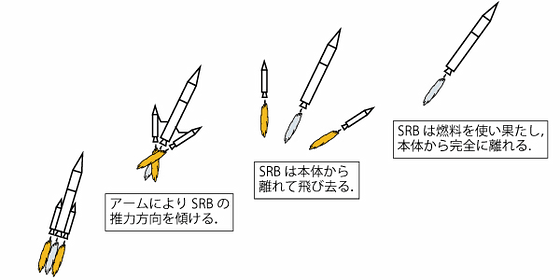
Even more amazing is the explanation of 'orbital mechanics'. ``In the opening section, especially from the beginning to around 1 minute and 30 seconds, the orbital mechanics are faithfully reproduced. I completely take my hat off to the production staff's knowledge and ability to express it.'' The most important part is the ``Hill's equation.'' ``At the beginning, the booster unit is separated, and it performs a maneuver (a series of procedures) to make an injection and move away from the main body. Some of you may be wondering about the direction of the jet and its movement during injection.''He explains as follows.
Based on the above, let's look at the case of Eva Q.
The movement of the first stage booster unit after separation was as shown in the figure below.
Immediately after separation, the booster unit moves straight away from the main body, but then activates the propulsion system and fires a jet in the same direction as the main body. Then, the booster unit increases its orbital altitude and decreases its orbital speed, so it moves further away from the main body while changing its direction of motion upward and behind the main body. Since this injection is performed continuously, the upward movement of the booster unit continues to accelerate.
By the way, the booster unit activated its propulsion system some time after it was separated from the main body. This time lag is because if the booster unit does not inject after it has moved away from the main body to a certain extent, there is a possibility that the booster unit will collide with the main body due to its subsequent upward movement. The movie takes this into consideration and expresses it.

The above part alone is astonishing, but the explanation below shows that even those seemingly incomprehensible movements were done properly.
Let's take a closer look at this movement. Since things are complicated, the diagram below is simplified and drawn using two boxes.
After the booster unit is separated from the main body, it injects the fuel so that it accelerates in the direction in which the main body moves. If you look at this objectively, it will look like the figure below.
Regarding the movement of these two, if the main body is fixed and the momentary position of the booster unit is drawn as the relative movement to the main body, it will be as follows.
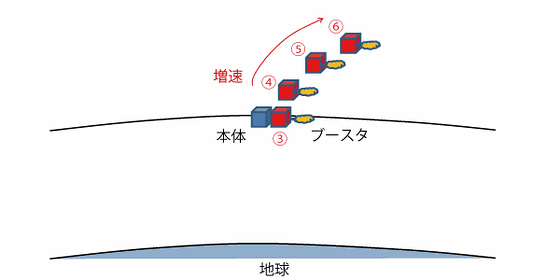
Also, after the first stage booster unit is separated, when the second stage starts jetting, all the parts and other floating objects that were scattered around it begin to move upward and backward all at once, as shown in the figure below.

And, to my horror, I have even discovered that this scene represents what happens when you look at these movements from the perspective of the ``tracking team'' mentioned in the first glossary.
This is the opposite of the previous case where the booster unit injects in the direction of speed increase, and the main body injects in the direction of deceleration, so as shown in the figure below, The main body will move forward and downward.
When you look at the video, the main body is always in the center of the screen, so the camera that shoots it also follows the main body, as shown in the figure below. The tracking team does a good job. Therefore, the floating object appears to be moving backwards and upwards.
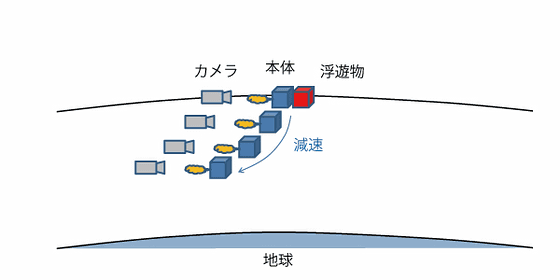
Just watching it up to this point is enough to make you shudder, but the scene where you can truly feel the awesomeness is the scene where they rob the coffin, which you thought was impossible. It says, ``Verification of the US operation,'' and it says, ``We will look at the US operation in the play, which is realized as space engineering,'' and ``Mass and thrust of the booster unit'', ``Eva and the coffin''. The figure below clarifies what kind of positional relationship they had by considering the 'mass of' and 'impulse approximation'.

Not only this, but also, ``Based on the trajectory in the previous section, we will calculate the distance when Asuka discovered Unit-01's coffin, and calculate the positional relationship between the two.In the movie, Unit-02 Kai discovers the coffin. is 67 seconds after injection.Then, you can see that the positional relationship is as shown in the diagram below.
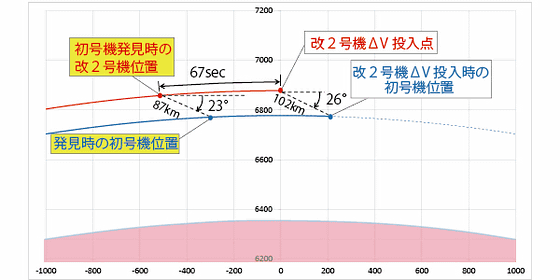
Finally, ``From the above, it can be said that the images of the deorbit phase are consistent with their feasibility,'' and what ``future challenges'' would be considered if we were to further refine the image expression. It's worth reading because it's an excellent piece of content, and it sheds light on what's going on. In fact, if you go to see Eva Q for the second or third time from now on, if you keep the above in mind before going to see it, you should be able to get a different impression.
Related Posts:
